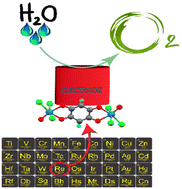Electrochemical water oxidation reaction by dinuclear Re(v) oxo complexes with a 1,4-benzoquinone core via the redox induced electron transfer (RIET) process†
Abstract
We report two dinuclear rhenium(V) oxo complexes 1 and 2 types, [ReV(O)(Cl)3(L2−)ReV(O)(Cl)3][NBu4]2 (1, L2− = dianionic 2,5-dihydroxy 1,4-benzoquinone (DBQ2−)) and (2, L2− = dianionic chloranilic acid (CA2−) ligands), as a homogeneous electrocatalyst for water oxidation reactions in the acetonitrile–water mixture. The evolution of dioxygen gas at the anode was confirmed by a GC-TCD study. In controlled potential electrolysis (CPE), oxidation at 1.30 V (vs. Ag/AgCl) at neutral pH, 1 and 2 afforded 1+ [ReVI(O)(Cl)3(DBQ˙3−)ReVI(O)(Cl)3]− and 2+ [ReVI(O)(Cl)3(CA˙3−)ReVI(O)(Cl)3]− ions, respectively, via the redox induced electron transfer (RIET) process. Electrochemically generated species of 1+ and 2+ could be isolated in dry acetonitrile. 1+ and 2+ ions give strong EPR signals in fluid solution as well as under frozen glass conditions due to the [ReVI(O)(Cl)3(L˙3−)ReVI(O)(Cl)3]− ↔ [ReVI(O)(Cl)3(L2−)ReV(O)(Cl)3]− (where L2− = DBQ2− and CA2−) equilibrium. However, the continuation of the CPE study (1.30 V vs. Ag/AgCl) in the presence of acetonitrile–water mixture oxidised the in situ generated species of 1+ and 2+ to higher valent ReVI![[double bond, length as m-dash]](https://www.rsc.org/images/entities/char_e001.gif) O species. These species (1+ and 2+) bound water through the water nucleophilic attack (WNA) to produce peroxide intermediate species of [ReV(OOH)(Cl)3(DBQ2−)ReV(OOH)(Cl)3] (A1) and [ReV(OOH)(Cl)3(CA2−)ReV(OOH)(Cl)3] (A2) for catalysts 1 and 2, respectively. Interestingly, A1 and A2 were authenticated and analysed by ESI mass spectrometry and infrared spectroscopy and were the active precursors of this water oxidation process. The extent of current generation under similar conditions suggested that complex 1 is superior to complex 2 for the water oxidation reaction. Notably, the maximum turnover frequency (TOFmax) of catalysts 1 and 2 were 2.1 and 1.6 s−1 at 0.27 V and 0.24 V over potential, respectively, which is very significant in WOR.
O species. These species (1+ and 2+) bound water through the water nucleophilic attack (WNA) to produce peroxide intermediate species of [ReV(OOH)(Cl)3(DBQ2−)ReV(OOH)(Cl)3] (A1) and [ReV(OOH)(Cl)3(CA2−)ReV(OOH)(Cl)3] (A2) for catalysts 1 and 2, respectively. Interestingly, A1 and A2 were authenticated and analysed by ESI mass spectrometry and infrared spectroscopy and were the active precursors of this water oxidation process. The extent of current generation under similar conditions suggested that complex 1 is superior to complex 2 for the water oxidation reaction. Notably, the maximum turnover frequency (TOFmax) of catalysts 1 and 2 were 2.1 and 1.6 s−1 at 0.27 V and 0.24 V over potential, respectively, which is very significant in WOR.



 Please wait while we load your content...
Please wait while we load your content...